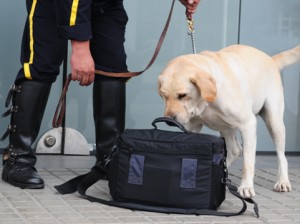The Detection Dog Dilemma
It’s fair to say that detection work was responsible for revitalizing the canine job market. For centuries, any reasonably motivated canine could count on a lifetime of steady employment in any number fields requiring canine assistance. Then, slowly, bit by bit, job after job, that long tradition of valuable service evaporated, turning the canine job picture into rust belt America.
It wasn’t that dogs suddenly remembered they had this spectacular skill sitting in the closet. It was a matter of Law Enforcement finally coming to grips with reality and giving their almost supernatural olfactory talent some respect. After that, it was off to the races. From the 1970s this career path blossomed into countless specialized branches with highly trained dogs selling for $20-$30,000, and frequently much more. However, the biggest sector of this job picture has always centered on drug detection work. It’s exciting and glamorous, and the demand for well-trained dogs has been insatiable.
So, now for the bad news; suddenly, legions of highly skilled, dedicated canines are facing early retirement as legalized weed sweeps the country.
The problem is that famous Supreme Court ruling a few years back that determined a detection dog’s alert constitutes probable cause to search. And needless to say, that alert can be triggered by anything that said dog has been trained to detect. Usually, that’s a predictable roster of popular drugs. Also, needless to say and previously covered here at CC, that ruling has also led to a legal fiesta as cases are regularly thrown out of court on the basis of improperly trained dogs. That ever-popular legal maneuver also thankfully ended the ill-advised cost cutting measure of cross-training dogs to alert on multiple triggers. Yeah, it appears that dogs are likely to get confused when prompted to search for fruit, flowers, counterfeit currency, C4, ancient artifacts, endangered species, and heroin.
However, when you narrow it down to a few key scents, wow, they are virtually infallible. Unfortunately, until recently one of those key scents has been the unmistakable, skunky aroma of weed. And as anyone reading this already knows, trying to un-train a dog is like trying to un-light a match. Once those reward pathways are seared into their brains, they will never forget where you dropped that donut or accidentally left that bitch in heat in the yard.
So, that sad fact is why thousands of detection dogs are now facing early retirement.
We are talking a lot of dogs and some very big money, actually enough to qualify for a recent New York Times front page story, okay? As noted in the opening paragraph “A dog can’t tell you, ‘Hey I smell marijuana’ or ‘I smell meth.’” Both of those, along with a few others will trigger the same alert response–which legally invalidates that dog’s reaction as probable cause to search. It’s a nationwide problem in Canada, which in a sense simplifies the situation. The whole country now requires brand new detection dogs.
Down here it’s more complicated–and changing every day as more states legalize medical marijuana, recreational marijuana, or both. For example, the article cited Michigan’s recent legalization vote that instantly put the state’s 50 detection dogs out to pasture.
Another source quoted in the story, Illinois sheriff Howard Buffett (son of Warren Buffett), added that the state’s entire 275 K-9 officers will be getting a pink slip, also insinuating that many of them may also face euthanasia as a result. That statement was quickly retracted as thousands of rehoming offers poured in from dog lovers worldwide. The department ultimately admitted that its retired K-9s are routinely adopted by their human partners. And that, of course, has always been the general policy for all branches of dog detection work.
Anyway, getting to the good news. All of these local, state, and federal agencies routinely shop for new dogs in Eastern Europe where the base price for untrained dogs starts around $6,000. Tack on the shipping, import fees and training, and we’re talking $20-$30k per dog. Now Labs and German Shepherds are not the only breeds used for this work, but they are definitely among the top five. They are also among the top five most popular breeds in America. So what is wrong with putting that Made in America slogan on our homegrown purebreds? Maybe when AKC takes a break from its doggy daycare ventures, it might look into this potential lifeline for American breeders.
And there’s gonna be a lot of job openings for America’s favorite breeds.
Short URL: http://caninechronicle.com/?p=156344
Comments are closed












